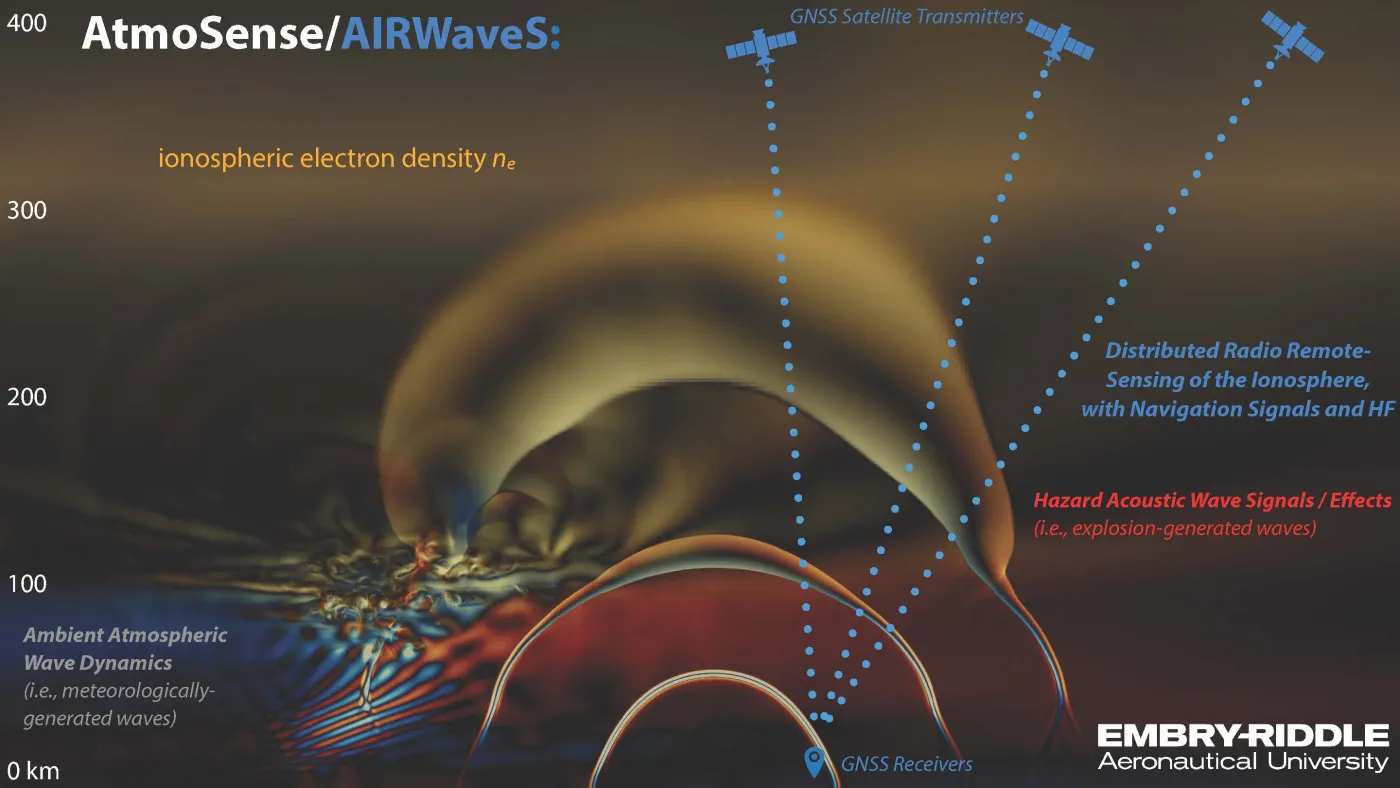
Mar 31, 2025
Researchers on DARPA's Atmosphere as a Sensor (AtmoSense) program will share scientific results with the defense and scientific community at a hybrid in-person and virtual workshop April 15-17, 2025, in Daytona Beach, Fla. The goal of the workshop is to build on the program's successes and catalyze further research and development for national security.
AtmoSense, which began in late 2020, set out to understand the fundamentals of energy propagation from the Earth’s surface to the ionosphere to determine whether the atmosphere can be used as a sensor. A fundamental science effort, AtmoSense aimed to measure acoustic and electromagnetic waves propagating through the atmosphere to see if they could provide clues about the nature, location, and size of a disturbance event that occurred on Earth. Precisely locating illicit underground explosions by a rogue nation or identifying other national security-relevant events could be done in the future just by using signals detected and modeled from the atmosphere. The open-source tools developed under AtmoSense may be the first step toward "reading" — from extended distances — information contained in atmospheric waves propagating from an event happening anywhere in the world.
Benefits for a range of computationally complex problems
"High-resolution surface-to-space simulation of acoustic waves was considered impossible before the program began, but we accomplished it," said Michael "Orbit" Nayak, DARPA AtmoSense program manager. "We used to call the ionosphere the 'ignorosphere,' but AtmoSense made some key interdisciplinary breakthroughs to address what used to be a massively intractable problem. We can now model across six orders of magnitude, in 3D, what happens to the energy emanating from a small, meters-scale disturbance as it expands up into the atmosphere to propagate over thousands of kilometers, and potentially around the world."
The April workshop will showcase AtmoSense tools and models, both to educate the atmospheric science community on new breakthroughs, and to spur discussion within the defense R&D ecosystem and broader scientific community about applications to other computationally challenging problems.
"Exciting as that is, the big win may lie beyond atmospheric science," Nayak continued. "The supercomputing solver advancement required to resolve the AtmoSense problem could enable simulations of other complex dynamics, across multiple spatial scales, that would have been too computationally expensive before. For example, these simulations could be applied to hypersonic modeling, any problem that needs to solve a Navier-Stokes fluid dynamics problem, or other big-compute ideas we haven't even considered yet. That's what I'm most excited about uncovering at our April event."
Atmospheric wave models validated against real-world detonations
The AtmoSense program included two phases, the first of which involved teams developing models for wave propagation from large events on Earth, such as earthquakes and volcanic eruptions (which measure in the kiloton to megatons range of explosive power). To test the precision of teams' predictive models and explore expanding the limit of detectability to smaller equivalent yields, a second phase of the program involved proof-of-principle testing against much smaller events.
In 2024, two field tests were conducted in New Mexico to conclusively validate DARPA AtmoSense models and establish an improved limit of detectability and geolocation. Each field test included two pairs of sequential 1-ton and one 10-ton controlled explosions, for a total of six detonations. The model predictions for wave propagation mirrored very closely the actual ground and airborne sensor readings from the test blasts, proving the simulation models' accuracy.
An unplanned discovery: SpaceX Falcon 9 re-entries detected
Following one of the New Mexico test-range detonations in 2024, a performer team noticed something unusual in their analysis of sensor data.
"As the team was looking at the data, they saw a huge drop in what's called total electron content that puzzled them," Nayak said. "Imagine that you have water going through a hose. That's a flow of electrons, and if you put your fist in front of the hose, you'll notice a significant drop in water volume coming out of the hose."
In preparing to analyze their field test data, the team noticed a similar sizable dip in the electron content compared to the background electron readings at a specific location in the atmosphere. As they did more forensics, they correlated the disturbance to a SpaceX Falcon 9 re-entry that happened the same day of the detonation test. Their sensor data had unexpectedly captured the SpaceX reentry into the atmosphere, resulting in the specific drop in electron content.
"Then they decided to pull other SpaceX reentry data, across dozens of launches, to see if they could spot a similar electron drop," Nayak said. "The phenomenon is highly repeatable. We discovered an unplanned new technique for identifying objects entering the earth's atmosphere." The Embry-Riddle University team, led by Jonathan Snively and Matt Zettergren, in collaboration with Pavel Inchin of Computational Physics, Inc., have submitted their novel results for peer-reviewed publication.
Embry-Riddle was the sole performer in Phase 2 of the AtmoSense program.
AtmoSense demonstrated that wave-propagation models were able to detect not only ground-based events but also air and space-based events of interest to national security.
Researchers and scientists interested in learning more about the findings of AtmoSense should register for the workshop.
